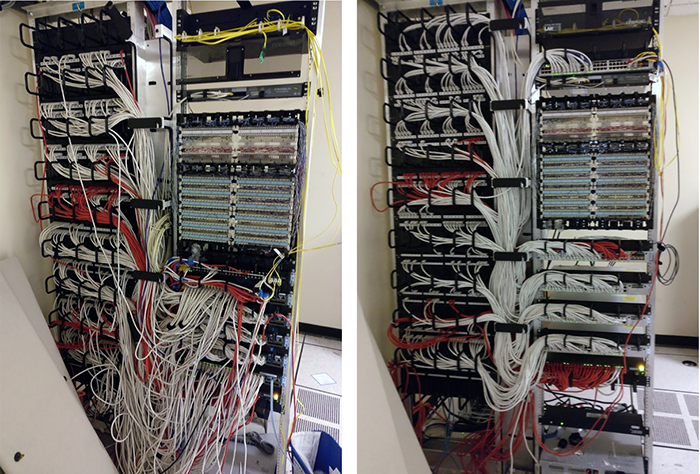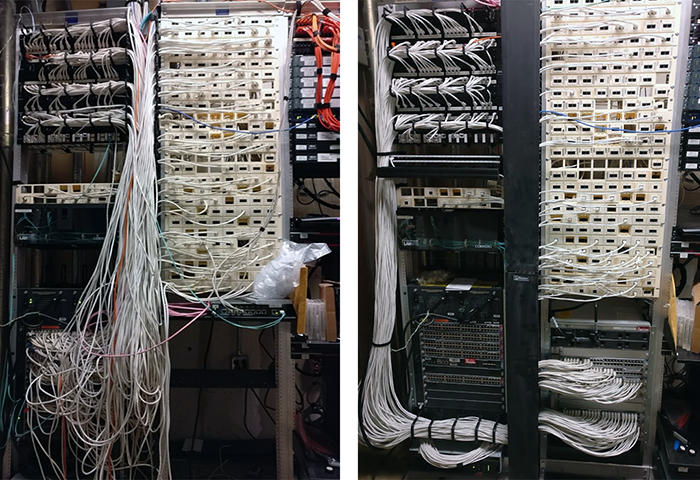You’re accessing archived content
This is archived content from the UIT website. Information may be outdated, and links may no longer function. Please contact stratcomm@it.utah.edu if you have any questions about archived content.

Meet Your Colleagues: Network Edge

Network Edge team, top, L-R: Chris Robinson and Tom Warnick; bottom, L-R: Nick Bradberry and Rick Titus.
Set designers on the original Star Trek series labeled some pipes on the Starship Enterprise “GNDN,” or “Goes Nowhere, Does Nothing.”
IT staff members who encounter spaghetti-like knots of cable in telecommunications closets get the joke, but heed it as a cautionary tale. A GNDW cable is the last thing you want to find in a cluttered comms closet, which explains why UIT’s Network Edge team is so meticulous about cable management.
“I appreciate good cable form,” said IT Specialist Nick Bradberry. “I love when everything is organized; that’s gorgeous and beautiful. The [obsessive compulsive] part of me goes ‘Ahhh…’”
The Network Edge team manages client network connectivity — “mostly the switches on the other side of the network jack in the wall,” said Network Engineer Chris Robinson.
If you think of networking as a relay race, edge is the final leg, generally from the internet service provider (ISP) to the end device. To make this hand off, an edge server is strategically placed as close as possible to the “last mile” — the last networking step between end devices and the internet of a wide body of endpoints (end devices making requests).

Before and after: Eccles Health Sciences Library, June 2019 (photo courtesy of Chris Robinson)

Before and after: Newborn Intensive Care Unit, April 2019 (photo courtesy of Chris Robinson)
“We work with the cable team to get your computer plugged into our gear, and we work with the Fiber Team to get our gear connected to the campus backbone,” Robinson said.
Classic network architecture consists of three layers:
- The core layer is made up of the biggest, fastest, and most expensive routers that merge geographically separated networks
- The distribution layer implements access lists and other filters, and ensures that packets, which carry data in the protocols used by the internet, are properly routed between subnets and virtual local area networks (VLANs)
- The access layer includes access switches connected to end devices (computers, printers, servers, etc.) that ensure packets are delivered
Though their responsibilities overlap with other Network Services teams, the Edge team represents the access layer.
Robinson said the team configures switches to accomplish three things:
- Network connections
- Logical grouping of similar devices, e.g., VLANs on routers and switches that allow devices to connect to the internet, but not to security systems
- Network infrastructure to support power over ethernet (PoE), which powers many network devices, primarily voice over IP (VoIP) phones, Wi-Fi access points (APs), and security cameras
“We aren’t just over end users with computers and phones; what we do is ensure connectivity over all edge devices, everything that wires into things,” Bradberry said, noting that edge devices is a “very large category” that comprises phones, camera systems, even devices like vending machines, cash registers, and medication dispensing systems.
Based on UIT’s system monitoring tool Orion, the team manages approximately 1,800 switches and 150,000 device interfaces, though Network Engineer Rick Titus estimates that number, all told, to be closer to 290,000. These aren’t just campus or hospital edge devices, Titus noted, they reflect remote sites like University of Utah Health centers in Midvalley, South Jordan, and Farmington, too.
“You have to look far and wide to find a bigger, better, faster network than we have at the U,” said Tom Warnick, technical supervisor of the Network Edge team. Warnick noted that in his 25-plus years at the U, he’s witnessed ethernet connectivity expand from 10 megabits to approximately 40 gigabits.
It’s clear that the team loves what they do.
“I like bragging about [the specifications] of network equipment,” said Robinson, who recently won a “guess that sound” contest (the answer, and reward, was a 160 GB hard drive that he’s reluctant to plug in because “I don't trust it.”). “It’s not interesting to most people to know that a switch can hold a Mac table of 12,800 Mac addresses and houses four power supplies of 3 kilowatts each.”
Daily operations, Edge team members said, haven't changed drastically since the pandemic. Aside from “more book-on-tape time” on his direct drive from to campus from home instead of the office, Warnick said his team has adapted remarkably well. Titus agreed.
“Generally speaking, whenever I’d go into a building to work, I might say hi to people there then walk into a closet, where I’m alone. Other than saying hi, that hasn’t really changed,” Titus said.
Because closets are shared, cables tend to become disorderly over time. Closets are accessed by groups that include UIT Voice Services technicians, local IT departments, Facilities Management staff who administer video cameras, techs from Field Services, Real Time Location System (RTLS) administrators, and even vendors like Verizon.
Due to this foot traffic and divergent best practices, Robinson said every possible state of cable management and rack style exists in the U’s network. Cable management (avoiding GNDN cables) he said, is essential to tracing and troubleshooting, copper and fiber cable upkeep, timely equipment replacement, and it “makes us look good to other departments we work with.”
Abraham Kololli, associate director of UIT Network Services, reiterated that the team indeed makes UIT look good, and not only with tidy cabling. The ongoing work they do related to the CARES Act amounts to installing approximately three years’ worth of hardware in only three months.
“The Edge team, they’re our boots on the ground. ... They’re our ninjas. We ask for their help and they’re there," Kololli said.
Node 4
Our monthly newsletter includes news from UIT and other campus/ University of Utah Health IT organizations, features about UIT employees, IT governance news, and various announcements and updates.
